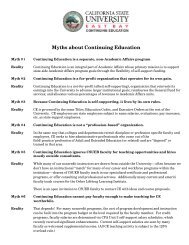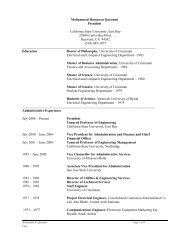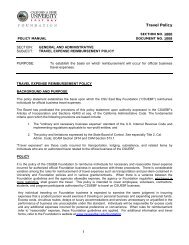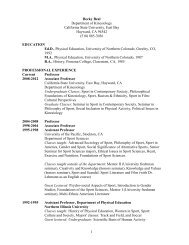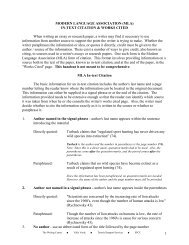Fall 2010 - California State University, East Bay
Fall 2010 - California State University, East Bay
Fall 2010 - California State University, East Bay
Create successful ePaper yourself
Turn your PDF publications into a flip-book with our unique Google optimized e-Paper software.
features<br />
In the casual office environment at The Daily Show’s New York City studio, comedy writer J.R. Havlan brings<br />
his Australian kelpie, Charlotte, to work daily. Most days he wears shorts on the job.<br />
When Stewart served as master of ceremonies for the<br />
2006 Academy Awards, for instance, it was a pop culture<br />
reference written by Havlan that critics applauded in<br />
newspapers and broadcasts the next day. “I do have some<br />
sad news to report,” Stewart deadpanned. “Björk couldn’t<br />
be here tonight. She was trying on her Oscar dress, and<br />
Dick Cheney shot her.”<br />
Editor’s note: At the 2001 ceremony, Icelandic singer<br />
Björk attracted global attention by wearing a wacky, white<br />
swan-inspired dress, while Cheney became the target of<br />
jokesters following his accidental shooting of a fellow hunter<br />
in 2006.<br />
Set piece<br />
As Havlan types, a regiment of 50 colorful, plastic<br />
Simpsons cartoon figurines oversees his progress from a<br />
nearby window ledge. A silver lava lamp filled with yellow<br />
globs bubbles lazily on his desk, while<br />
at his feet, Charlotte, his well-trained<br />
Australian kelpie, dozes, ready to leap<br />
up and scamper after him when he<br />
heads down the hall for a rare trip to<br />
The Daily Show set.<br />
Weaving through the show’s<br />
warren of offices, narrow corridors and<br />
occasionally sloping hallways, Havlan<br />
arrives at a nondescript door. Pushing past<br />
it, Havlan enters a short dark hall before<br />
veering into the brightly lit, red-andblue<br />
themed Daily Show set familiar<br />
to viewers. “We just told the designers<br />
we wanted something that Ted Koppel<br />
would want for Christmas,” Havlan says.<br />
The wall to the right features<br />
a large-scale scene of the New York<br />
skyline at night. Straight ahead, a<br />
platform containing an executive-style<br />
cherry wood desk sits like an island<br />
at the center of the set. It’s here that<br />
Stewart delivers his nightly parody of<br />
the news to a live audience. The gallery<br />
sits empty during the day, but at 5 p.m.<br />
each evening audience members stream<br />
in — often after an hours-long wait queued up around the<br />
block. An oversized, digitized globe dangling overhead<br />
flashes a nonsensical string of words. This week it’s Juneau,<br />
Junizawa, Junedale, and Junejani.<br />
To the left, a green screen stretches toward the<br />
ceiling. During rehearsal a couple hours later, the show’s<br />
correspondents will act out a bit called “The Spilling<br />
Fields” in front of the blank screen. Audience members<br />
at home, however, will see a scene of Louisiana wetlands<br />
projected on the screen, as if the correspondents were<br />
reporting about the gulf oil spill on location. On air,<br />
Stewart wears a suit, just like a network anchorman, but<br />
while running through lines for the correspondents’ bit<br />
he sports a comfy gray T-shirt. Most days, the confident<br />
Stewart requires no rehearsal, but this afternoon the cast is<br />
helping correspondent Olivia Munn warm up for her first<br />
appearance on the program.<br />
“A lot of times, Jon goes through rehearsals with his feet up on the desk,” says<br />
Havlan, noting that Stewart’s casual appearance and demeanor reflects a credible<br />
and easy delivery style that doesn’t require him to “sell anything.”<br />
While the atmosphere in the office and on the set appears relaxed, the cast and<br />
crew take their jobs seriously — to an extent. And Havlan’s respect for Stewart, who<br />
took over as host in 1999, is evident.<br />
Political player<br />
“In the beginning of 2000, the content became far more political,” Havlan says.<br />
“When the election came up, we were in a unique position, and Jon realized this is<br />
what we’re here for. That’s when we started to focus on media coverage.”<br />
Over several episodes, Daily Show correspondents spoofed politicians and<br />
press coverage of the presidential election campaign. Its take on “Indecision 2000”<br />
earned the show, including Havlan, the first of two Peabody Awards for excellence<br />
in broadcasting. (“Indecision 2004” received a Peabody in 2005.)<br />
Given such accolades, perhaps it’s not surprising that the program also<br />
has become the subject of serious study. The Pew Research Center’s Project<br />
for Excellence in Journalism, for instance, studied the show’s content for a year,<br />
comparing its agenda to traditional news outlets’. The center’s analysis included the<br />
following observation:<br />
The Daily Show aims at more than comedy. In its choice of topics, its use of<br />
news footage to deconstruct the manipulations by public figures and its<br />
tendency toward pointed satire over playing just for laughs, The Daily Show<br />
performs a function that is close to journalistic in nature — getting people to<br />
think critically about the public square.<br />
“Different outlets have been saying that for a while or claiming studies<br />
(demonstrate) the show’s influence on the public,” Havlan says. “We don’t sit<br />
around thinking about it … We don’t come in and say, ‘How are we going to affect<br />
the media landscape Are we going to increase the number of kids who get their<br />
news from The Daily Show’ There’s no insidious plan.”<br />
<strong>East</strong> <strong>Bay</strong> beginnings<br />
As a kid growing up in Danville, Havlan didn’t yearn for a career in show biz<br />
and never expected one day he’d get paid to be funny.<br />
He didn’t take acting classes or perform stand-up comedy until after graduating<br />
from Cal <strong>State</strong> <strong>East</strong> <strong>Bay</strong>, although for Halloween one year in grade school he<br />
dressed up as mute comic Harpo Marx. By the time he enrolled in business courses<br />
at then-Cal <strong>State</strong> Hayward in the 1980s, Havlan assumed he’d spend his career at a<br />
typical office job.<br />
“My sense of humor was there, but I didn’t think of being a comic,” he says. “My<br />
idea was to go to college and get a business degree.”<br />
Havlan’s professional fate may have come as less of a surprise to his closest<br />
friend from college, attorney Bill Schott ’88. Schott remembers well Havlan’s<br />
On winning Emmys: “Few if any accomplishments<br />
in my life have measured up to the honor<br />
of winning an Emmy Award. It is literally a<br />
reflection of the respect people in your industry<br />
have for the work that you do. It is indeed a<br />
humbling experience. With that said, once they<br />
give you the trophy they have almost no say over<br />
what you do with it.”<br />
— J.R. Havlan<br />
22 Cal <strong>State</strong> <strong>East</strong> <strong>Bay</strong> Magazine | FALL <strong>2010</strong><br />
Cal <strong>State</strong> <strong>East</strong> <strong>Bay</strong> Magazine | FALL <strong>2010</strong><br />
23





